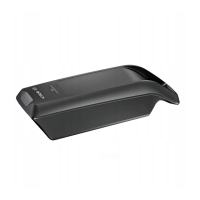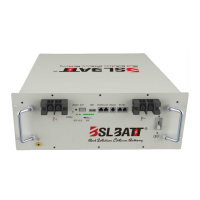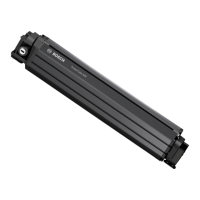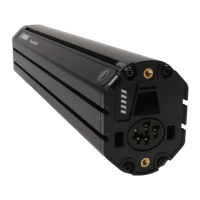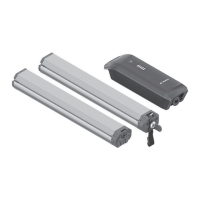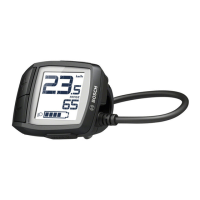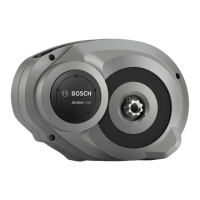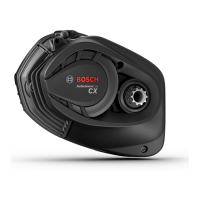English–2
0 275 007 ADC | (1.4.16) Bosch eBike Systems
Assembly
Inserting and removing the battery pack
For inserting and removing the eBike battery pack in/from the
eBike, please read and observe the battery pack operating in-
structions.
Checking the Speed Sensor (see figure A)
The speed sensor 2 and its spoke magnet 3 must be mounted
in such a manner that the spoke magnet, after a turn of the
wheel, moves past the speed sensor with a clearance of at
least 5 mm, yet no more than 17 mm.
Note: If the distance between speed sensor 2 and spoke mag-
net 3 is too small or too large, or if the speed sensor 2 is not
properly connected, the speed indication will fail, and the
eBike drive unit will operate in emergency mode.
In this case, loosen the screw of the spoke magnet 3 and fas-
ten the spoke magnet to the spoke in such a manner that it
runs past the mark of the speed sensor at the correct clear-
ance. If the speed is still not being indicated in the speed indi-
cation after this, please contact an authorised bicycle dealer.
Operation
Initial Operation
Requirements
The eBike system can only be activated when the following
requirements are met:
– A sufficiently charged battery pack is inserted (see battery
pack operating instructions).
– The on-board computer is properly inserted in the holder
(see on-board computer operating instructions).
– The speed sensor is connected properly (see “Checking
the Speed Sensor”, page English–2).
Switching the eBike System On/Off
Options for switching on the eBike system:
– If the on-board computer is already switched on when you
insert it into the holder, then the eBike system will be
switched on automatically.
– With the on-board computer and the eBike battery pack in-
serted, briefly press the On/Off button of the on-board com-
puter (see on-board computer operating instructions).
– When the on-board computer is inserted, press the On/Off
button of the eBike battery pack (see battery pack operat-
ing instructions).
The drive is activated as soon as you step on the pedals (ex-
cept when in the push aid feature, see “Switching the Push-
assistance mode On/Off”, page English–3). The motor out-
put depends on the settings of the assistance level on the on-
board computer.
As soon as you stop pedaling when in normal operation, or as
soon as you have reached a speed of 25 km/h, the assistance
from the eBike drive is switched off. The drive is automatically
re-activated as soon you start pedaling again and the speed is
below 25 km/h.
Options for switching off the eBike system:
– Press the On/Off button of the on-board computer.
– Switch the eBike battery pack off by its On/Off button (see
battery pack operating instructions).
– Remove the on-board computer out of its holder.
If the eBike is not moved and no button is pressed on the on-
board computer for 10 minutes, the eBike system will shut
down automatically in order to save energy.
eShift (optional)
eShift is the integration of automatic gear shifting systems in-
to the eBike system. The eShift components are electrically
connected to the drive unit by the manufacturer. The opera-
tion of automatic gear shifting systems is described in the op-
erating instructions of the on-board computer.
Setting the Assistance Level
On the on-board computer you can set how much the eBike
drive assists you while pedalling. The assistance level can be
changed at any time, even while cycling.
Note: For individual versions, it is possible that the assistance
level is pre-set and cannot be changed. It is also possible that
less assistance levels are available for selection than listed
here.
The following assistance levels (max.) are available:
– “OFF”: The motor assistance is switched off, and the eBike
can be moved as a normal bicycle only by pedalling. The
push assistance cannot be activated in this assistance level.
– “ECO”: Effective assistance at maximum efficiency for
maximum cruising range
– “TOUR”: Uniform assistance, for touring with long cruising
range
– “SPORT”: Powerful assistance for sportive riding off road
as well as for urban traffic
– “TURBO”: Maximum assistance, supporting highest ca-
dence for sportive riding
The requested motor output appears on the display of the on-
board computer. The maximum motor output depends on the
selected assistance level.
Assistance Level Assistance Factor*
“ECO”
40%
“TOUR”
100%
“SPORT”
150%
“TURBO”
250 %
* The motor output can vary for individual versions.
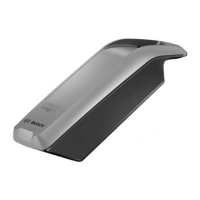
